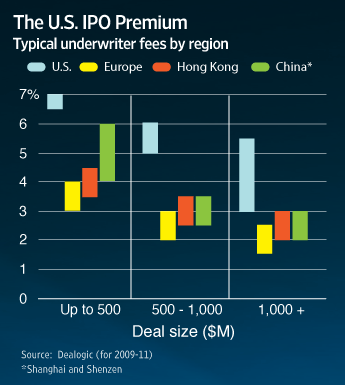HONG KONG (Dow Jones Investment Banker) – Underwriters persistently rake in higher IPO fees in the US than in other markets. But with foreign companies increasingly shunning US listings, the American premium may be hard to sustain.
With proceeds of almost US$31 billion raised, Hong Kong remained the most active listing location in the world in 2011, narrowly beating the New York Stock Exchange and Nasdaq taken together, according to Dealogic. The total is not even close when all Chinese exchanges are included: The proceeds from US IPOs amounted to just 42% of those in the Chinese markets.
But, in spite of this, the US alone generated more than 45% of global investment banking revenue (across all products) in 2011 – almost 12 times that for the entire Asia-Pacific region. One of the reasons: higher ECM fees in the US in what was a mixed year for equity offerings, with few deals in the second half.
While ECM fees have gradually been falling in Europe and Asia, they remain abnormally high stateside, for no very obvious reason. Only in mainland China – a market so far closed to international issuers – can one also find, on occasion, IPO fees reaching the 6% mark, and those are mostly smaller transactions.
Former vice chairman of investment banking at UBS David (now Lord) Freud mentions in his 2006 memoirs (“Freud In The City,” Bene Factum Publishing) that the practice in the US is the result of a de facto cartel of investment banks, and that any firm undercutting its rivals faces the risk of exclusion from underwriting syndicates.

One might think that banks would have an incentive to discount fees to win lead mandates because junior underwriters in a syndicate dominated by bookrunner banks (and, in the US, by “active” rather than “passive” bookrunners at that) don’t see such high fees. Securing lead mandates with the help of a competitive fee quote should be worth more than the dollars that can be earned taking on a minor role.
So it’s surprising that such regional disparity in ECM commissions has remained, despite recent notable cases. Fees for the US$8 billion IPO of Banco Santander (Brasil) SA, the largest flotation on the NYSE in 2009, were only 1.75%. And Goldman Sachs reportedly offered a fee of only 0.75% – well below that pitched by its rivals – in a bid to lead the US$23.1 billion NYSE IPO of the restructured General Motors Co. in mid-2010. But these remain isolated examples involving rare and sought-after mega-deals.
Some fee discounting occurs in a variety of markets where international – including US houses – jockey to gain market share, especially in jurisdictions where local houses have an edge through long-established lending relationships. India, South Korea and Taiwan are obvious examples, particularly in the case of follow-on offerings, where “league table material” privatizations have been conducted with fees of just a few basis points.
One suspects the peculiarities of the US market – for example, the absence of pre-deal research, the “pot system” for the allocation of ECM fees and a complex and litigious legal environment – will for some time prevent new entrants from making significant inroads by simply charging less. Barclays Capital and UBS became noted players in the U.S. ECM market, but not by pursuing a strategy of undercutting their peers.
International corporates, with the exception perhaps of Chinese Internet players, continue their exodus from the US exchanges. As cross-border listings become more common, and as significant platforms like the Stock Exchange of Hong Kong (and perhaps soon Shanghai) increasingly open up to issuers globally, the US market could perhaps find itself falling in line with the wider world.
(Philippe Espinasse worked as an investment banker in the U.S., Europe and Asia for more than 19 years and now writes and works as an independent consultant in Hong Kong. Visit his website at https://www.ipo-book.com. Readers should be aware that Philippe may own securities related to companies he writes about, may act as a consultant to companies he mentions and may know individuals cited in his articles. To comment on this column, please email [email protected]).
[This article was originally published on Dow Jones Investment Banker on 6 January 2012 and is reproduced with permission.]
Copyright (c) 2012, Dow Jones & Company, Inc.
